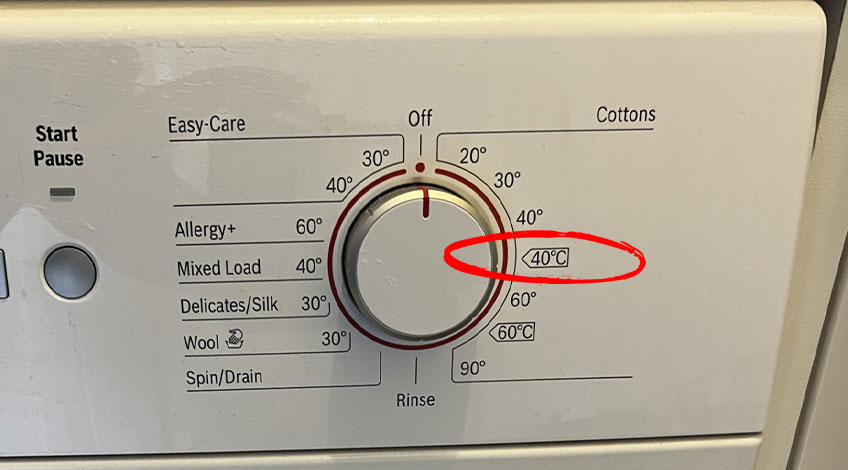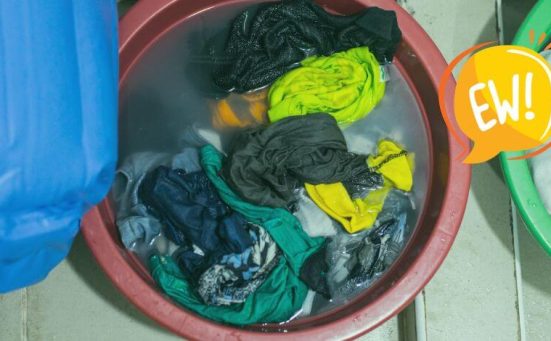
Laundry Coming Out Of Washing Machine Badly Creased? (try doing this)
Have you ever unloaded your washing machine only to find your clothes resembling crumpled paper? Believe it or not, this is a common issue that many experience.
There are many options you can choose from to prevent creasing your clothes, such as tweaking your machine’s settings, sorting your clothes, choosing the correct water temperature, and more.
Let’s go over each method in this article so you can reduce those annoying creases on your fabrics and make your laundry sessions more efficient!
Adjust Your Washing Machine’s Settings
Your washing machine’s settings play an extremely important role in the outcome of your laundry. After all, just using the wrong programme can be the reason why your clothes are coming out of the machine wrinkled in the first place.

Many modern machines come with specific options designed to reduce wrinkling. Make sure to look for settings like “anti-crease” or “easy iron”. These settings adjust the wash cycle, reducing the intensity of agitation that will be less likely to twist and wrinkle your clothes.
TIP: Always read your appliance’s user manual to know the right setting for the load you’re doing.
Use The Correct Water Temperature
Using the right water temperature can greatly affect how wrinkled your clothes get during washing. Hence, it can be a factor as to why you’re finding yourself having to iron those clothes in the first place.
Hot water can relax fibres, but too much heat may also set wrinkles into fabrics. On the other hand, cold water is gentler but may not clean your clothes as effectively.

The best thing you can do is to choose a moderate temperature that is best for the load you’re washing to minimise creasing.
TIP: Make sure to read the care labels on your garments for the recommended wash temperature. You don’t want to shrink your garments!
Sort Your Clothes Properly
Sorting isn’t just about separating darks from lights – it also involves separating fabrics that are prone to wrinkling from those that aren’t.
We get it, sometimes it can be too time-consuming to separate clothes by fabric and colour, but if you want to reduce wrinkling on your garments, it’s just something you need to do.
Always keep heavier items like denim and towels separate from light fabrics such as shirts and blouses. This will prevent heavier items from pressing and creasing lighter items during the spin cycle.
Do Not Overload The Machine
Overloading your washing machine is a surefire way to end up with a creased laundry load. Why? Because clothes need space to move freely in the water for the detergents to work effectively without becoming entangled.

An overloaded machine will restrict movement, causing the fabrics to compress and wrinkle. Make sure to know your machine’s capacity in order to avoid overloading. Generally, the recommended amount of laundry you’ll wash should be between ½ to ¾ of your washer’s capacity.
SEE ALSO: How Much Should You Fill A Washing Machine? (easy guide)
Avoid Underloading Your Machine
Just as overloading can cause issues, underloading can also lead to creases. Without enough items in the drum, clothes have too much space to move, and this can lead to them twisting around each other.
Like many things, it’s about finding the right balance to allow clothes to move freely but not excessively. Having too much space in your washer’s drum during the cycle can also cause too much agitation on your clothes, which could result in tearing or damage.
SEE ALSO: Is It Bad To Underload Your Washing Machine?
Use The Right Amount Of Detergent
If you think it’s ridiculous that laundry detergent may be the culprit as to why your clothes are wrinkly after putting them in the washing machine, there is an explanation for that.
Using too much detergent can leave a residue on clothes, which not only affects the cleanliness but also increases the likelihood of creases appearing. This is because the residue can hold fibres in a rigid form, which makes them more prone to creasing.

To prevent this, measure your detergent according to the manufacturer’s instructions and consider the hardness of your water, as harder water may require slightly more detergent.
Use A Fabric Softener
Fabric softeners or a natural alternative like white vinegar can help soften fibres and reduce static, making fabrics less prone to wrinkling after being put in the washing machine.
- Natural and eco-friendly: Pure Chem's White Vinegar is made from natural ingredients, free from harsh chemicals and additives, and is a safe and eco-friendly alternative to traditional cleaning products.
- Versatile cleaning agent: This vinegar's acidic properties make it a powerful cleaner, cutting through grease, grime, and stains on a variety of surfaces. It can be used to clean floors, tiles, countertops, and even as a natural fabric softener.
White vinegar, in particular, helps to relax fibres naturally during the wash cycle. Just add half a cup to the rinse cycle for a natural, chemical-free way to combat creases.
TIP: Have sensitive skin? Use white vinegar as a fabric softener alternative!
Choose A Lower Spin Speed
A high spin speed can remove more water and shorten drying time, but it can also cause clothes to press against the sides of the drum, leading to creases that are hard to remove.
Go for a lower spin speed if your clothes are coming out of the washing machine overly wrinkled. Although this might mean a slightly longer drying time, it could save you ironing time later.
SEE ALSO: What Washing Machine Spin Speed Is Gentle?
Remove Laundry After The Cycle Is Complete
Letting clothes sit in the washing machine after the cycle has finished can cause creases to set in, as the clothes remain crumpled up in the drum. Not only that, but it also allows mould and mildew to grow, making your clothes and machine smell foul.

Remove your laundry as soon as the cycle is complete and give each item a good shake to remove any creases before drying.
Dry The Laundry ASAP
Drying clothes immediately after washing can also prevent wrinkles. Hang clothes up or dry them in a tumble dryer right away.
If you’re air drying, hang clothes neatly and straight to encourage a smooth drying process. For tumble drying, using dryer balls can help to fluff up the fibres and reduce creasing.
And there you have it! By doing the methods above, you can make sure that your clothes come out looking their best while reducing the need to iron and steam your fabrics.
The next time you load your machine, remember the tips we mentioned and you’ll have a more pleasant laundry experience.
Do you have questions? Feel free to leave a comment below!
Frequently Asked Questions
Your clothes may come out of the washing machine creased due to several factors, such as using incorrect settings, overloading or underloading the machine, selecting the wrong water temperature, or leaving clothes in the drum too long after the cycle finishes.
To fix creased clothes, adjust your washing machine settings to include options like “anti-crease” or “easy iron,” use the correct amount of detergent, select a moderate wash temperature, and remove your laundry promptly after the cycle ends. Additionally, choosing a lower spin speed can help reduce creasing.
Washing clothes alone may not get rid of creases, especially if not done properly. However, using the right settings and techniques, such as proper temperature selection, using fabric softener, and removing clothes immediately after washing, can help minimise creases.
Fabrics that crease easily typically include cotton, linen, and rayon. These materials tend to wrinkle more than synthetic fibres like polyester or nylon, especially when not handled correctly during the washing and drying processes.
White vinegar is an excellent alternative to commercial fabric softeners for reducing creases. It helps to relax fibres naturally during the wash cycle and is a natural, chemical-free option. Just add half a cup to your rinse cycle.
Also, follow us on Pinterest ...




